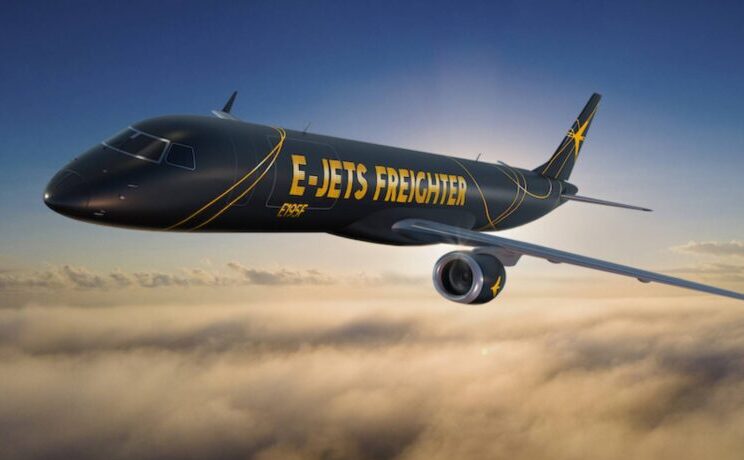Aerospace
Embraer Signs a Firm Contract for up to 10 Passenger to Freight Conversions

- First firm contract for Embraer’s P2F comes after an agreement announced in May with Nordic Aviation Capital (NAC) for up to 10 conversion slots for E190F/E195F;
- Deliveries to start in 2024;
- E-Jets Freighters offer over 50% more volume capacity, three times the range of large cargo turboprops, and up to 30% lower operating costs than narrowbodies;
[the_ad id=”13559″]
São José dos Campos, Brazil, June 24, 2022 – Embraer [B3: EMBR3, NYSE: ERJ] has signed a firm order for up to 10 Embraer E-Jets Passenger to Freight (P2F) conversions with an undisclosed customer. Aircraft for conversion will come from the customer’s current E-Jets fleet, with deliveries starting in 2024. This is the first firm contract for Embraer’s P2F, being the second agreement for this kind of operation. In May, Embraer and Nordic Aviation Capital (NAC) announced an agreement in principle to take up to 10 conversion slots for E190F/E195F.
Embraer’s E-Jets P2F conversions deliver segment-leading performance and economics. The E-Jets Freighters will have over 50% more volume capacity, three times the range of large cargo turboprops, and up to 30% lower operating costs than narrowbodies.
With more than 1,600 E-Jets delivered by Embraer globally, P2F customers benefit from a well-established, mature, global services network, in addition to a comprehensive portfolio of products ready to support their operations from day one.
[the_ad id=”13557″]
The conversion to freighter will be performed at Embraer’s facilities in Brazil and includes main deck front cargo door; cargo handling system; floor reinforcement; Rigid Cargo Barrier (RCB) – 9G Barrier with access door; cargo smoke detection system (class E main deck cargo compartment), Air Management System changes (cooling, pressurization, etc.); interior removal and provisions for hazardous material transportation.
Combining under-floor bulk cargo and main deck, the maximum gross structural payload is 13,150kg for the E190F and 14,300kg for the E195F. Considering typical e-commerce cargo density, the net weights and volumes are also impressive:the E190F can handle a payload of 23,600lb (10,700kg) while the E195F a payload of 27,100 lb (12,300 kg).

Aerospace
Boeing Transfers Rocket Stage to NASA, Paving Way for Human Moon Mission

Boeing has achieved a significant milestone by providing NASA with the second core stage of the Space Launch System (SLS) rocket.
This crucial component, crafted at NASA’s Michoud Assembly Facility (MAF), is set to propel the Artemis II crew into lunar orbit, marking humanity’s return to deep space after a 50-year hiatus.
The monumental Boeing-built rocket stage, the largest element of the Artemis II mission, will embark on a journey aboard the Pegasus barge, traveling 900 miles to NASA’s Kennedy Space Center.
Comparison of two legendary aircraft B777x vs B747 aircraft:Click here
Upon arrival, it will be meticulously integrated with other essential Artemis II components, including the upper stage, solid rocket boosters, and NASA’s Orion spacecraft within the iconic Vehicle Assembly Building. This intricate integration process is a vital step toward the eagerly anticipated Artemis II launch, slated for 2025.
“Boeing-built products helped land humankind on the moon in 1969, and we’re proud to continue that legacy through the Artemis generation,” remarked Dave Dutcher, vice president and program manager for Boeing’s SLS program. “Together, with NASA and our industry partners and suppliers, we are building the world’s most capable rocket and paving the way to deep space through America’s rocket factory in New Orleans.”
NASA, Lockheed Martin Reveal X-59 Quiet Supersonic Aircraft:Click here
The delivery of Core Stage 2 marks a significant achievement in the evolution of the SLS rocket. Towering over 200 feet and powered by four RS-25 engines, this core stage, coupled with two solid-fueled booster rockets, will generate a staggering 8.8 million pounds of thrust. This immense power is crucial to launching Artemis II and future missions into the vast expanse of space.
The SLS rocket stands unparalleled in its capability to transport both crew and substantial cargo to the moon and beyond in a single launch. Its extraordinary capacity will facilitate the delivery of human-rated spacecraft, habitats, and scientific missions to destinations including the moon and Mars, ushering in a new era of space exploration.
-

 Travel1 week ago
Travel1 week agoAir India to Expand US Operations with Three New Routes After a Decade
-

 Travel2 weeks ago
Travel2 weeks agoWhy We Should Avoid These Stamps in a Passport
-

 Airlines1 month ago
Airlines1 month agoInvestigations Reveal Fake Chinese Titanium in Boeing and Airbus Jets
-

 Tech4 weeks ago
Tech4 weeks agoChina’s CATL Plans 1,800-Mile Electric Plane Launch by 2027
-

 Airport3 days ago
Airport3 days agoTop 10 Largest Airports in the World by Size
-

 Aerospace4 weeks ago
Aerospace4 weeks agoChina’s Fighter Jets Turn Wings into Autonomous Drones
-

 Airlines4 days ago
Airlines4 days agoAir India Rolls Out A350s for Delhi-New York JFK and Newark Routes
-

 Defence3 weeks ago
Defence3 weeks agoBoeing Enhances Chinook with New Engines and Block II Upgrades at $96 Million







